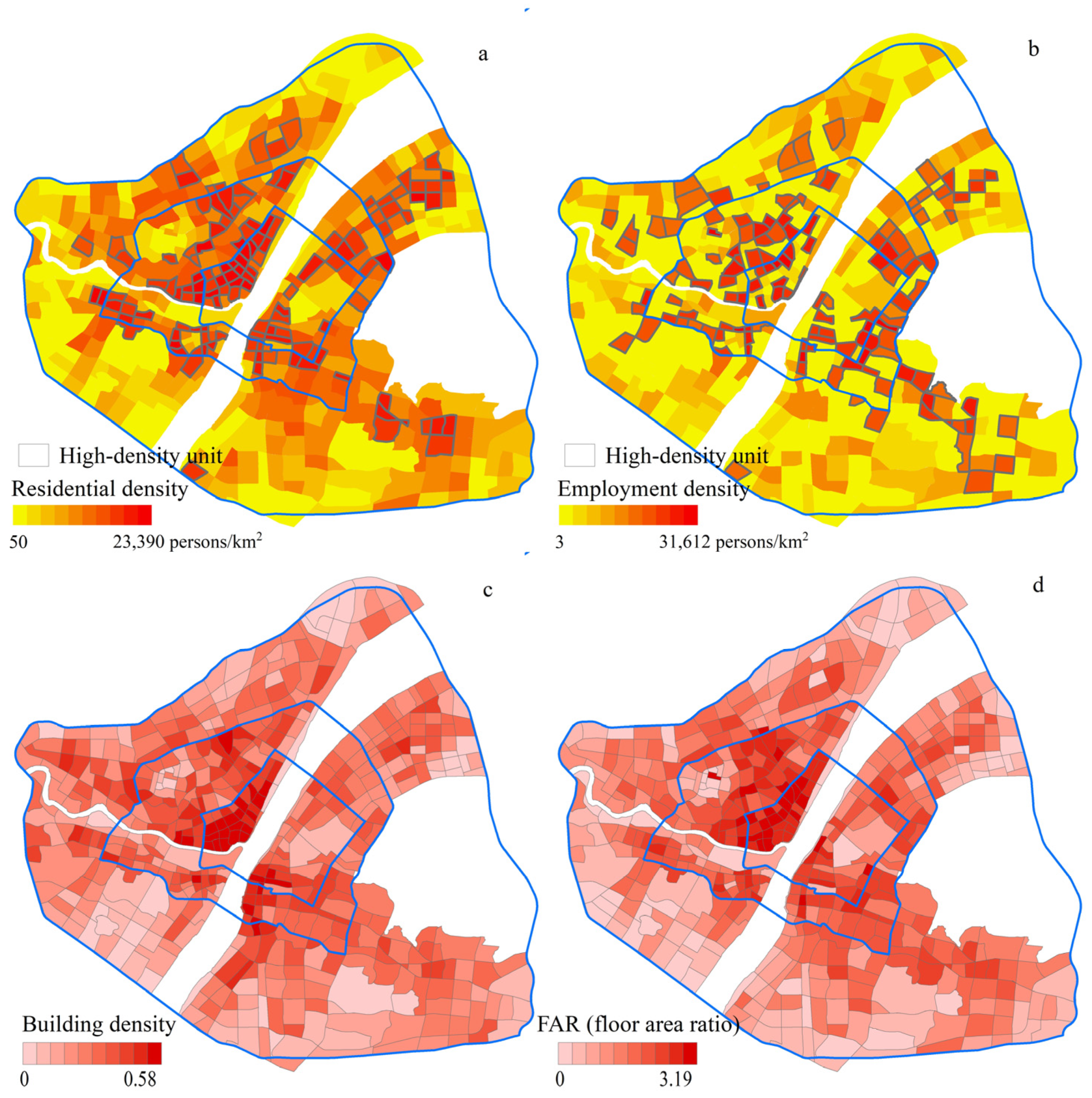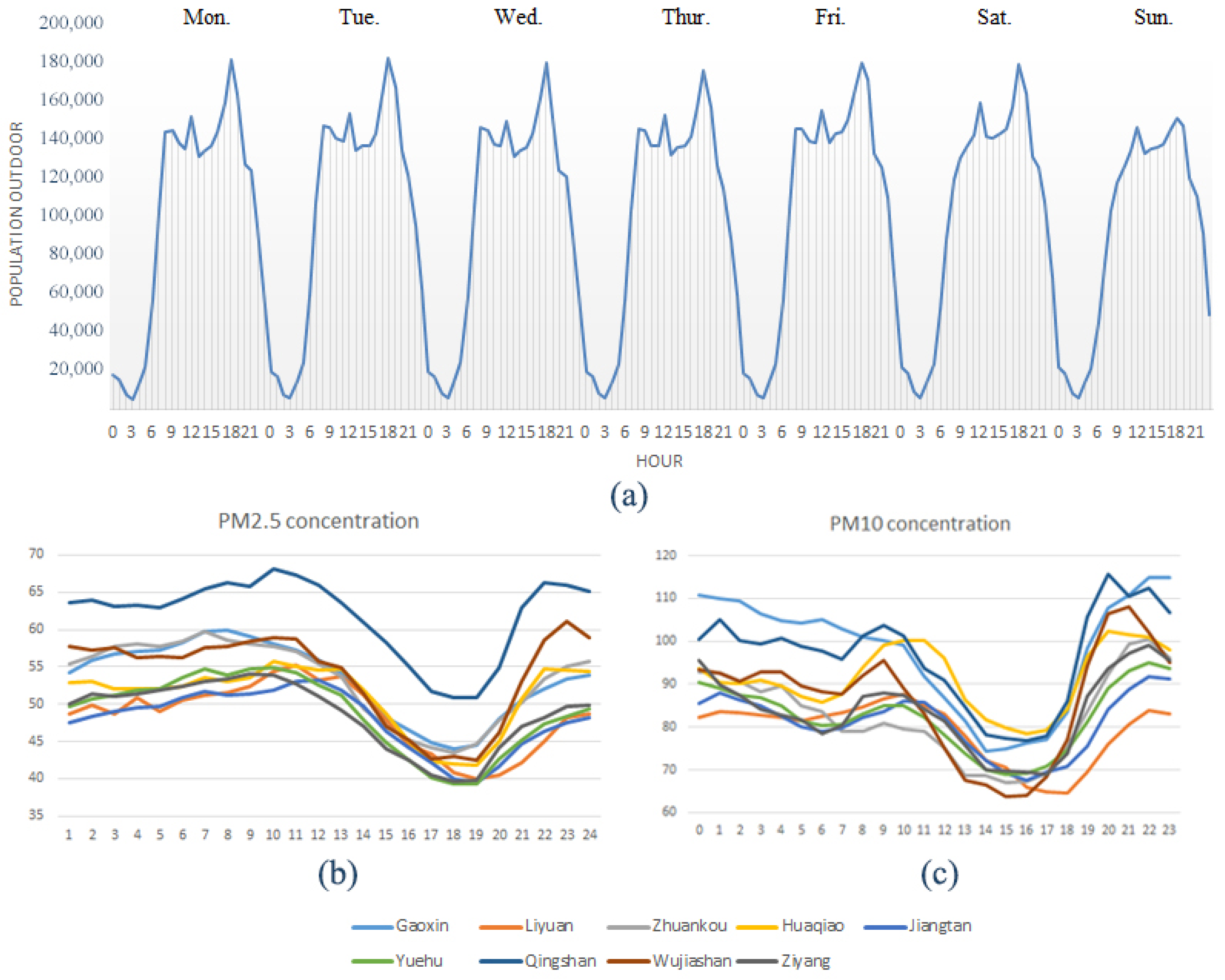Is Compact Urban Form Good for Air Quality? A Case Study from China Based on Hourly Smartphone Data
Abstract
1. Introduction
Literature Review
2. Data and Methodology
2.1. Study Area
2.2. Data
2.3. Exposure Assessment and Compactness Measures
3. Results
3.1. Population Density
3.2. Air Pollution Concentration
3.3. Air Pollution Exposure
4. Discussion
5. Conclusions
Author Contributions
Funding
Institutional Review Board Statement
Informed Consent Statement
Data Availability Statement
Conflicts of Interest
References
- Beelen, R.; Hoek, G.; Brandt, P.A.V.D.; Goldbohm, R.A.; Fischer, P.; Schouten, L.J.; Jerrett, M.; Hughes, E.; Armstrong, B.; Brunekreef, B. Long-Term Effects of Traffic-Related Air Pollution on Mortality in a Dutch Cohort (NLCS-AIR Study). Environ. Heal. Perspect. 2008, 116, 196–202. [Google Scholar] [CrossRef]
- Chen, X.; Shao, S.; Tian, Z.; Xie, Z.; Yin, P. Impacts of air pollution and its spatial spillover effect on public health based on China’s big data sample. J. Clean. Prod. 2017, 142, 915–925. [Google Scholar] [CrossRef]
- Han, X.; Liu, Y.; Gao, H.; Ma, J.; Mao, X.; Wang, Y.; Ma, X. Forecasting PM2.5 induced male lung cancer morbidity in China using satellite retrieved PM2.5 and spatial analysis. Sci. Total. Environ. 2017, 607–608, 1009–1017. [Google Scholar] [CrossRef]
- OECD. The Cost of Air Pollution: Health Impacts of Road Transport; OECD Publishing: Paris, France, 2014. [Google Scholar]
- Ewing, R.; Cervero, R. Travel and the built environment: A meta-analysis. J. Am. Plan. Assoc. 2010, 76, 265–294. [Google Scholar] [CrossRef]
- Cervero, R.; Murakami, J. Effects of Built Environments on Vehicle Miles Traveled: Evidence from 370 US Urbanized Areas. Environ. Plan. A Econ. Space 2010, 42, 400–418. [Google Scholar] [CrossRef]
- Bartholomew, K.; Ewing, R. Land use–transportation scenarios and future vehicle travel and land consumption: A meta-analysis. J. Am. Plan. Assoc. 2008, 75, 13–27. [Google Scholar] [CrossRef]
- Zhao, P.; Lü, B.; de Roo, G. Urban expansion and transportation: The impact of urban form on commuting patterns on the city fringe of Beijing. Environ. Plan. A 2010, 42, 2467. [Google Scholar] [CrossRef]
- Schweitzer, L.; Zhou, J. Neighborhood air quality, respiratory health, and vulnerable populations in compact and sprawled re-gions. J. Am. Plan. Assoc. 2010, 76, 363–371. [Google Scholar] [CrossRef]
- Stone, B. Urban sprawl and air quality in large US cities. J. Environ. Manag. 2008, 86, 688–698. [Google Scholar] [CrossRef] [PubMed]
- Rodríguez, M.C.; Dupont-Courtade, L.; Oueslati, W. Air pollution and urban structure linkages: Evidence from European cities. Renew. Sustain. Energy Rev. 2016, 53, 1–9. [Google Scholar] [CrossRef]
- Yuan, M.; Huang, Y.; Shen, H.; Li, T. Effects of urban form on haze pollution in China: Spatial regression analysis based on PM2.5 remote sensing data. Appl. Geogr. 2018, 98, 215–223. [Google Scholar] [CrossRef]
- Sarrat, C.; Lemonsu, A.; Masson, V.; Guédalia, D. Impact of urban heat island on regional atmospheric pollution. Atmos. Environ. 2006, 40, 1743–1758. [Google Scholar] [CrossRef]
- Taha, H. Meso-urban meteorological and photochemical modeling of heat island mitigation. Atmos. Environ. 2008, 42, 8795–8809. [Google Scholar] [CrossRef]
- Yuan, M.; Song, Y.; Huang, Y.; Hong, S.; Huang, L. Exploring the Association between Urban Form and Air Quality in China. J. Plan. Educ. Res. 2018, 38, 413–426. [Google Scholar] [CrossRef]
- Gariazzo, C.; Pelliccioni, A.; Bolignano, A. A dynamic urban air pollution population exposure assessment study using model and population density data derived by mobile phone traffic. Atmos. Environ. 2016, 131, 289–300. [Google Scholar] [CrossRef]
- Cho, H.-S.; Choi, M.J. Effects of Compact Urban Development on Air Pollution: Empirical Evidence from Korea. Sustainability 2014, 6, 5968–5982. [Google Scholar] [CrossRef]
- Liu, C.; Henderson, B.H.; Wang, D.; Yang, X.; Peng, Z.R. A land use regression application into assessing spatial variation of in-tra-urban fine particulate matter (PM2.5) and nitrogen dioxide (NO2) concentrations in City of Shanghai, China. Sci. Total Environ. 2016, 565, 607–615. [Google Scholar] [CrossRef] [PubMed]
- Zou, B.; Luo, Y.; Wan, N.; Zheng, Z.; Sternberg, T.; Liao, Y. Performance comparison of LUR and OK in PM2.5 concentration mapping: A multidimensional perspective. Sci. Rep. 2015, 5, srep08698. [Google Scholar] [CrossRef] [PubMed]
- Chen, J.; Chen, S.; Landry, P.F. Migration, environmental hazards, and health outcomes in China. Soc. Sci. Med. 2013, 80, 85–95. [Google Scholar] [CrossRef]
- Larkin, A.; Hystad, P. Towards Personal Exposures: How Technology Is Changing Air Pollution and Health Research. Curr. Environ. Heal. Rep. 2017, 4, 463–471. [Google Scholar] [CrossRef]
- Reis, S.; Seto, E.; Northcross, A.; Quinn, N.W.T.; Convertino, M.; Jones, R.L.; Maier, H.R.; Schlink, U.; Steinle, S.; Vieno, M. Inte-grating modelling and smart sensors for environmental and human health. Environ. Model. Softw. 2015, 74, 238–246. [Google Scholar] [CrossRef]
- Su, J.G.; Jerrett, M.; Meng, Y.-Y.; Pickett, M.; Ritz, B. Integrating smart-phone based momentary location tracking with fixed site air quality monitoring for personal exposure assessment. Sci. Total. Environ. 2015, 506–507, 518–526. [Google Scholar] [CrossRef] [PubMed]
- Wu, Y.; Wang, R.; Zhou, Y.; Lin, B.; Fu, L.; He, K.; Hao, J. On-Road Vehicle Emission Control in Beijing: Past, Present, and Future. Environ. Sci. Technol. 2011, 45, 147–153. [Google Scholar] [CrossRef]
- Huang, J.; Lu, X.; Sellers, J.M. A global comparative analysis of urban form: Applying spatial metrics and remote sensing. Landsc. Urban Plan. 2007, 82, 184–197. [Google Scholar] [CrossRef]
- Bento, A.M.; Cropper, M.L.; Mobarak, A.M.; Vinha, K. The Effects of Urban Spatial Structure on Travel Demand in the United States. Rev. Econ. Stat. 2005, 87, 466–478. [Google Scholar] [CrossRef]
- Civerolo, K.; Hogrefe, C.; Lynn, B.; Rosenthal, J.; Ku, J.-Y.; Solecki, W.; Cox, J.; Small, C.; Rosenzweig, C.; Goldberg, R. Estimating the effects of increased urbanization on surface meteorology and ozone concentrations in the New York City metropolitan re-gion. Atmos. Environ. 2007, 41, 1803–1818. [Google Scholar] [CrossRef]
- Hankey, S.; Marshall, J.D. Impacts of urban form on future US passenger-vehicle greenhouse gas emissions. Energy Policy 2010, 38, 4880–4887. [Google Scholar] [CrossRef]
- Martins, H. Urban compaction or dispersion? An air quality modelling study. Atmos. Environ. 2012, 54, 60–72. [Google Scholar] [CrossRef]
- Ewing, R.; Pendall, R.; Chen, D. Measuring sprawl and its transportation impacts. Transp. Res. Rec. J. Transp. Res. Board 2003, 1831, 175–183. [Google Scholar] [CrossRef]
- Bechle, M.J.; Millet, D.B.; Marshall, J.D. Effects of Income and Urban Form on Urban NO2: Global Evidence from Satellites. Environ. Sci. Technol. 2011, 45, 4914–4919. [Google Scholar] [CrossRef] [PubMed]
- Bereitschaft, B.; Debbage, K. Urban form, air pollution, and CO2 emissions in large US metropolitan areas. Prof. Geogr. 2013, 65, 612–635. [Google Scholar] [CrossRef]
- Lu, C.; Liu, Y. Effects of China’s urban form on urban air quality. Urban Stud. 2016, 53, 2607–2623. [Google Scholar] [CrossRef]
- Liu, Y.; Arp, H.P.H.; Song, X.; Song, Y. Research on the relationship between urban form and urban smog in China. Environ. Plan. B Urban Anal. City Sci. 2016, 44, 328–342. [Google Scholar] [CrossRef]
- Yuan, M.; Song, Y.; Hong, S.; Huang, Y. Evaluating the effects of compact growth on air quality in already-high-density cities with an integrated land use-transport-emission model: A case study of Xiamen, China. Habitat Int. 2017, 69, 37–47. [Google Scholar] [CrossRef]
- Calabrese, F.; Colonna, M.; Lovisolo, P.; Parata, D.; Ratti, C. Real-Time Urban Monitoring Using Cell Phones: A Case Study in Rome. IEEE Trans. Intell. Transp. Syst. 2010, 12, 141–151. [Google Scholar] [CrossRef]
- Nyhan, M.; Grauwin, S.; Britter, R.; Misstear, B.; McNabola, A.; Laden, F.; Barrett, S.R.; Ratti, C. ‘Exposure Track’—The Impact of Mobile Device Based Mobility Patterns on Quantifying Population Exposure to Air Pollution. Environ. Sci. Technol. 2016, 50, 9671–9681. [Google Scholar] [CrossRef]
- Zhou, S.; Lin, R. Spatial-temporal heterogeneity of air pollution: The relationship between built environment and on-road PM2.5 at micro scale. Transp. Res. Part D 2019, 76, 305–322. [Google Scholar] [CrossRef]
- Chen, X.; Feng, J. Effects of built environment based on a comparison of walkability and air pollution: A case study of Nanjing city. Prog. Geogr. 2019, 38, 296–304. [Google Scholar]
- Huang, J.; Deng, F.; Wu, S.; Guo, X. Comparisons of personal exposure to PM2.5 and CO by different commuting modes in Beijing, China. Sci. Total. Environ. 2012, 425, 52–59. [Google Scholar] [CrossRef] [PubMed]
- Wang, L.; Jiang, X.; Sun, W.; Zhao, X.; Tang, J. Impact of urban built environment on respiratory health and its planning strategy: A case study of a district in shanghai. City Plan. Rev. 2018, 42, 15–22. (In Chinese) [Google Scholar]
- Li, T.; Shen, H.; Yuan, Q.; Zhang, X.; Zhang, L. Estimating Ground-Level PM2.5 by Fusing Satellite and Station Observations: A Geo-Intelligent Deep Learning Approach. Geophys. Res. Lett. 2017, 44, 11–985. [Google Scholar] [CrossRef]








| Region | Metrics | PM2.5 | PM10 | ||||
|---|---|---|---|---|---|---|---|
| All Day | Morning Peak | Evening Peak | All Day | Morning Peak | Evening Peak | ||
| All | Building density | −0.199 ** | −0.211 ** | −0.197 ** | −0.157 ** | −0.173 ** | −0.175 ** |
| FAR | −0.248 ** | −0.282 ** | −0.262 ** | −0.157 ** | −0.181 ** | −0.237 ** | |
| High-density residential units | Building density | −0.355 ** | −0.383 ** | −0.326 ** | −0.263 ** | −0.308 ** | −0.267 ** |
| FAR | −0.438 ** | −0.492 ** | −0.429 ** | −0.279 ** | −0.335 ** | −0.347 ** | |
| High-density employment units | Building density | −0.253 ** | −0.256 ** | −0.214 * | −0.201 * | −0.251 ** | −0.148 |
| FAR | −0.323 ** | −0.364 ** | −0.302 ** | −0.181 * | −0.241 ** | −0.212 * | |
| Region | Metrics | PM2.5 | PM10 | ||||||
|---|---|---|---|---|---|---|---|---|---|
| All Day | Morning Peak | Noon | Evening Peak | All Day | Morning Peak | Noon | Evening Peak | ||
| All | Building density | 0.650 ** | 0.648 ** | 0.640 ** | 0.635 ** | 0.651 ** | 0.644 ** | 0.642 ** | 0.637 ** |
| FAR | 0.781 ** | 0.782 ** | 0.770 ** | 0.767 ** | 0.784 ** | 0.780 ** | 0.774 ** | 0.769 ** | |
| High-density residential units | Building density | 0.426 ** | 0.410 ** | 0.462 ** | 0.342 ** | 0.440 ** | 0.419 ** | 0.477 ** | 0.355 ** |
| FAR | 0.581 ** | 0.607 ** | 0.607 ** | 0.477 ** | 0.604 ** | 0.625 ** | 0.626 ** | 0.495 ** | |
| High-density employment units | Building density | 0.304 ** | 0.292 ** | 0.297 ** | 0.263 ** | 0.311 ** | 0.291 ** | 0.308 ** | 0.275 ** |
| FAR | 0.462 ** | 0.500 ** | 0.461 ** | 0.396 ** | 0.481 ** | 0.511 ** | 0.480 ** | 0.411 ** | |
Publisher’s Note: MDPI stays neutral with regard to jurisdictional claims in published maps and institutional affiliations. |
© 2021 by the authors. Licensee MDPI, Basel, Switzerland. This article is an open access article distributed under the terms and conditions of the Creative Commons Attribution (CC BY) license (https://creativecommons.org/licenses/by/4.0/).
Share and Cite
Yuan, M.; Yan, M.; Shan, Z. Is Compact Urban Form Good for Air Quality? A Case Study from China Based on Hourly Smartphone Data. Land 2021, 10, 504. https://doi.org/10.3390/land10050504
Yuan M, Yan M, Shan Z. Is Compact Urban Form Good for Air Quality? A Case Study from China Based on Hourly Smartphone Data. Land. 2021; 10(5):504. https://doi.org/10.3390/land10050504
Chicago/Turabian StyleYuan, Man, Mingrui Yan, and Zhuoran Shan. 2021. "Is Compact Urban Form Good for Air Quality? A Case Study from China Based on Hourly Smartphone Data" Land 10, no. 5: 504. https://doi.org/10.3390/land10050504
APA StyleYuan, M., Yan, M., & Shan, Z. (2021). Is Compact Urban Form Good for Air Quality? A Case Study from China Based on Hourly Smartphone Data. Land, 10(5), 504. https://doi.org/10.3390/land10050504





